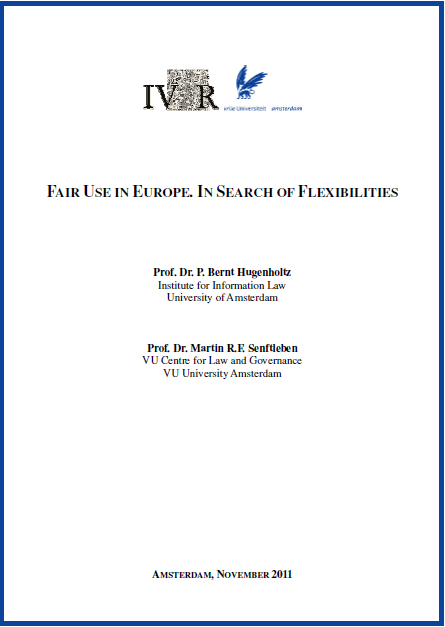Fair Use in Europe. In Search of Flexibilities
P.B. Hugenholtz en M.R.F. Senftleben, Fair use in Europe. In search of flexibilities, IViR, 14 november 2011 en pdf.
 Inleidende woorden van Thijs van den Heuvel, Bird & Bird en met dank aan Martin Senftleben, VU en Bird & Bird.
Inleidende woorden van Thijs van den Heuvel, Bird & Bird en met dank aan Martin Senftleben, VU en Bird & Bird.
In deze studie onderzoeken prof. dr. P. Bernt Hugenholtz (Institute for Information Law, University of Amsterdam) en prof. dr. Martin R. F. Senftleben (VU Centre for Law and Governance, VU) de noodzaak en mogelijkheden van meer flexibiliteit in het auteursrecht.
Why is there a need for flexibilities in copyright law today and to what extent are open norms compatible with the copyright system? Does the EU and international legal framework leave Member States discretion to adopt in their national laws open ‘fair use’ style limitations and exceptions to copyright? What kinds of flexibility presently exist in national copyright law?
Zij concluderen dat er op Europees en nationaal niveau nooit eerder zoveel behoefte is geweest aan flexibiliteit in het auteursrecht. De auteurs pleiten niet voor de introductie van een “American-style general fair use provision”, maar doen de aanbeveling “to introduce a measure of flexibility alongside the existing structure of limitations and exceptions, and thus combine the advantages of enhanced flexibility with legal security and technological neutrality.”
De huidige Europese regelgeving op het gebied van auteursrecht biedt volgens de onderzoekers meer ruimte voor flexibiliteit dan wellicht gedacht. In de eerste plaats bieden de beperkingen in de Auteursrechtrichtlijn (2001/29) aan de lidstaten van de EU een ruime mate van implementatievrijheid. Hiernaast bestaat er ruimte voor de lidstaten, omdat the right of adaption grotendeels niet is geharmoniseerd.
Lidstaten die ten volle gebruik willen maken van de beschikbare beleidsruimte “might achieve this by literally transposing the Directive’s entire catalogue of exception prototypes into national law. In combination with the three-step test, this would effectively lead to a semi-open norm almost as flexible as the fair use rule of the United States.”
Lidstaten die flexibele bepalingen willen introduceren krijgen ten slotte het advies om hiermee niet te wachten tot er op Europees niveau flexibele bepalingen worden geïntroduceerd:
“Member states (…) are advised to take advantage of the policy space that presently exists in EU law, and not wait until initiatives to introduce flexibilities at the EU level materialize. In this way, national models can be developed and tested in practice that may serve as a basis for more flexible future law making at EU level.”























































































